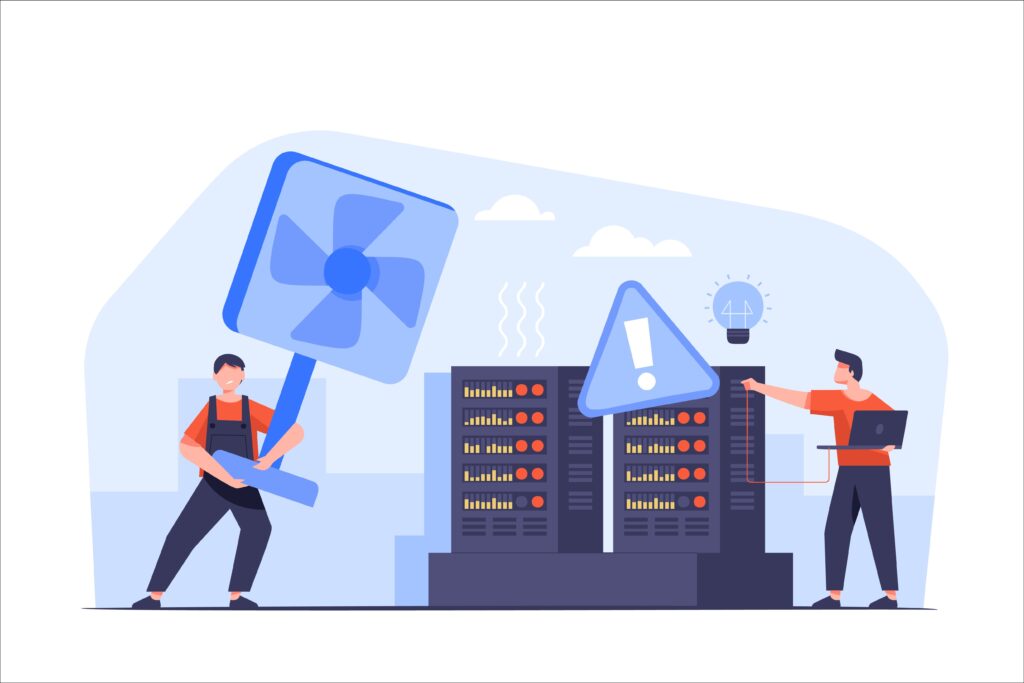
Table of Contents
Hot Aisle Containment Explained
If you’ve ever walked into an old-school server room, you understand the amount of heat that servers, storage, and network infrastructure can generate. It can get hot! This is why hot aisle containment is a critical aspect of data center design.
Heat is the enemy of technology equipment. In order to prevent damage to equipment, the environment where the equipment is running must be cooled to no more than 82 degrees. In order to keep the environment cool, hot air needs to be removed and replaced with cool air.
The challenge in a data center, or in a larger on-premise server room, is there is a lot of hot air being generated in a large, open space. Cooling the space while equipment continually generates more heat and mixes with cooled air is expensive and inefficient. Therefore, containing the hot air to keep it physically separated from cold air makes a lot of sense. Hot aisle containment solves this challenge.
How Hot Aisle Containment Works
Hot aisle containment physically isolates hot air from cold air. In order to achieve this, two things are required. First, server racks much be lined up in alternating rows, with hot air exhausts facing one another. This forces all of the hot air in the same direction, as seen below.

Second, a hot aisle containment system must be deployed. This is a physical barrier that traps the hot air, and prevents it from mixing with cold air. Containment barriers range from containment curtains, to modular data center containment walls and ceilings.
The image below shows a hot aisle / cold aisle configuration with containment walls deployed:

Once the hot air is contained and isolated, it is either exhausted from the data center, or returned to the data center’s Computer Room Air Conditioning (CRAC) units for cooling. This leaves the larger data center or server room floor cooled to the appropriate temperature for computer equipment (typically between 50 degrees and 82 degrees Fahrenheit) and also at a comfortable temperature for employees working in the data center.
Implementing hot aisle containment solutions in buildings that are built for colocation is easy and affordable. The benefits are many including:
- Lower power costs due to more efficient cooling
- Lower energy usage providing a greener data center
- Longer run time on equipment due to consistent, appropriate temperature levels
- A more comfortable and consistent temperature on the data center floor
Cold Aisle Containment – An Alternate Approach
In some circumstances, cold aisle containment may make more sense. Cold aisle containment is basically the opposite of hot aisle containment. The isolated area between network racks is pumped with cool air. The hot air is then exhausted into the larger area of the surrounding room.
The image below is an illustration of cold aisle containment where cool air is being pumped from the floor, and expelled out of the exhaust fans into the larger room.

Cold aisle containment is typically cheaper and easier to implement in an area that is being retrofitted to purposes of a data center, as it does not require raised flooring, and because it can be built around existing obstructions. It is typically less efficient, however, and heats up the surrounding space which could cause issues with both safety and comfort. When it can be implemented at a reasonable cost, hot aisle containment is the preferred data center containment design.
Hot Aisle Containment Solutions
Containment is as simple as putting up a barrier that isolates the hot air. Depending on scope and budget, solutions are as simple as a vinyl hot aisle containment curtain, or as complex as modular, framed room enclosures complete with doors and roofs.
Containment solutions are available from a number of vendors. APC, Chatsworth, Eaton, Legrand, Panduit, Polargy, Subzero, and more offer solutions to address needs in the market. Polargy’s solutions are outstanding. Unlike some other providers, their entire business is focused on containment solutions. Their products are designed and manufactured in the USA, and they have a fantastic US based sales and engineering team to serve clients.
How can Brightlio help?
Brightlio’s data center consulting services can help you design, purchase and deploy hot aisle and cold aisle containment solutions. Brightlio partners with Polargy, the leading provider of hot and cold aisle containment for new and retrofitted data centers. Whether you need to isolate a few cabinets or design the containment solution for a hyperscale data center, Brightlio and Polargy have the solutions you need to recognize significant cost savings through improved airflow management.
Brightlio also offers advisory services, including data center consulting services, as well as unified communications, connectivity, and cloud solutions.
Contact Brightlio today for a quote and solution design for a Polargy containment solution. We appreciate the opportunity to partner with you.
Recent Posts
Vancouver Data Centers: Colocation in the Pacific Northwest
Business Broadband Solutions: The Ultimate Guide
Let's start
a new project together



